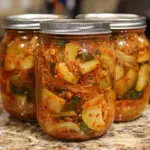Description
Learn how to make homemade kimchi with our step-by-step guide! This traditional Korean kimchi recipe is full of flavor and health benefits.
Ingredients
Ingredients List
Here’s what you’ll need to make traditional napa cabbage kimchi:
- Napa Cabbage: 1 large head, quartered and chopped
- Korean Radish: 1 medium radish, julienned
- Gochugaru (Korean Chili Flakes): ¼–½ cup, depending on spice preference
- Salt: ¼ cup, for salting the cabbage
- Fish Sauce: 2–3 tablespoons, or substitute with soy sauce/miso for vegan kimchi
- Garlic: 5–6 cloves, minced
- Ginger: 1 tablespoon, minced
- Green Onions: 4, chopped into 1-inch pieces
- Optional Sweetener: 1–2 tablespoons sugar, grated apple, or pear for natural sweetness
Instructions
Step-by-Step Instructions
- Salting the Cabbage
- Quarter and Rinse: Cut the napa cabbage into quarters and rinse each piece thoroughly under cool water. This initial rinse removes any dirt and helps prepare the cabbage for salting.
- Salt the Cabbage: Sprinkle salt generously between each leaf, especially near the thick stems where more salt is needed to draw out water. Place the cabbage in a large mixing bowl and let it sit for 1–2 hours, turning every 30 minutes to ensure even salting.
- Rinse and Drain: After salting, rinse the cabbage thoroughly under cold water to remove excess salt. Squeeze out excess water gently and set aside.
- Prepare the Kimchi Paste
- Combine Ingredients: In a separate mixing bowl, combine gochugaru, fish sauce (or vegan substitute), minced garlic, ginger, and optional sweetener (such as sugar, grated apple, or pear).
- Mix Thoroughly: Stir until a thick paste forms. Adjust the amount of gochugaru based on desired spice level, and taste the paste for a balanced flavor. The paste should have a balanced, slightly sweet, and spicy flavor.
- Massage the Paste into the Cabbage
- Add Radish and Green Onions: Add the julienned radish and chopped green onions to the bowl with the cabbage.
- Massage with Gloves: Wearing gloves, scoop the paste onto the cabbage leaves, radish, and green onions. Massage it into each leaf, ensuring that every part is well-coated. This step is important for even fermentation and flavor distribution.
- Packing the Kimchi for Fermentation
- Pack Tightly into a Jar: Transfer the coated cabbage mixture into a clean glass or ceramic jar. Press down firmly to remove any air pockets and allow the natural brine to rise to the surface. Leave about an inch of space at the top of the jar to allow for expansion during fermentation.
- Add Weight (Optional): Place a fermentation weight on top of the cabbage to keep it submerged in the brine. This step prevents exposure to air, which is essential for proper fermentation.
- Fermentation Process
- Seal and Leave at Room Temperature: Cover the jar loosely to allow gases to escape, or use a fermentation lid if available. Let the kimchi ferment at room temperature for 1–5 days, depending on the desired sourness. Check daily to press down the cabbage if needed and taste-test for preferred flavor.
- Refrigerate: Once the kimchi reaches your preferred level of tanginess, seal the jar tightly and store it in the refrigerator. This slows down fermentation, preserving the flavor and texture. Kimchi will continue to develop flavor over time.
Notes
Troubleshooting Common Kimchi Issues
Fermenting kimchi is relatively straightforward, but a few issues can arise. Here are solutions to common kimchi problems to ensure the best results.
1. Kimchi is Too Salty
- Solution: If the kimchi tastes too salty after the initial fermentation, soak the cabbage in water for 30 minutes before fermenting to draw out excess salt. Another option is to add more fresh, unsalted cabbage or vegetables to balance out the saltiness.
- Preventive Tip: Always rinse the salted cabbage thoroughly before mixing it with the kimchi paste. Using coarse sea salt instead of table salt can also prevent over-salting.
2. Kimchi is Not Fermenting Properly
- Solution: Fermentation is temperature-dependent, so if it’s too cold, the process may be slower. Allow the kimchi to ferment at room temperature for a few extra days. Make sure to taste daily, then refrigerate once it reaches the desired level of tanginess.
- Preventive Tip: Ideal fermentation occurs at room temperature (65–75°F). In cooler climates, you can place the kimchi near a warm spot (but not in direct sunlight) to encourage fermentation.
3. Kimchi Smells Too Strong or Sour
- Solution: Kimchi naturally develops a strong aroma as it ferments, but excessive sourness may indicate over-fermentation. Use over-fermented kimchi in cooked dishes like stews or kimchi pancakes, where the intense flavor can enhance the recipe.
- Preventive Tip: Store kimchi in the refrigerator once it reaches your preferred flavor. If you want a milder taste, refrigerate earlier in the fermentation process.
4. Mold Appears on Kimchi
- Solution: Mold can form if kimchi is exposed to air. If you notice mold on the surface, carefully remove the top layer of kimchi. If the mold is pervasive, discard the batch.
- Preventive Tip: Always ensure the kimchi is submerged in brine, and press down the vegetables regularly to remove air pockets. A fermentation weight can help keep the kimchi submerged.
5. Kimchi is Too Mild
- Solution: Mild kimchi might need more time at room temperature to develop flavor. Let it ferment for an additional 1–2 days, taste-testing daily. Adding a bit more gochugaru to the paste can also boost the flavor if you prefer a spicier result.
- Preventive Tip: To ensure a bold flavor, use high-quality gochugaru and fish sauce. Adjust spices based on your preferred flavor profile before beginning fermentation.
